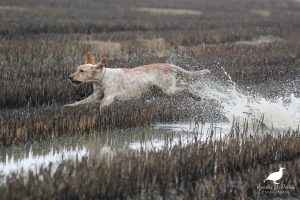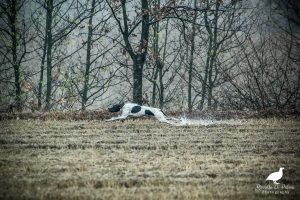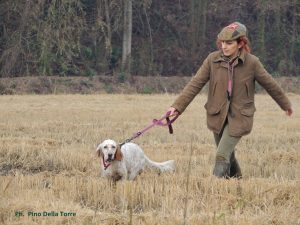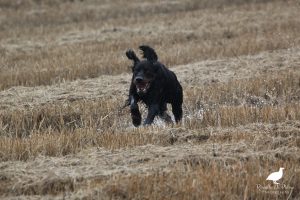Diamanti in palude: le prove a beccaccini
Ho una predilezione per il beccaccino, vai a capire il perché. Sì, certo preferisco le grouse ma il beccaccino non è male e mi aiuta a gestire l’assenza delle prime. Io e il beccaccino siamo vecchi amici, ci siamo incontrati nel 2004, l’hanno in cui ho preso la prima licenza di caccia. Per accorciare una lunga storia, ero venuta a sapere dei beccaccini attraverso i libri e i racconti dei cacciatori, ma non li avevo mai visti dal vivo fino a quando Spina, una setter inglese, ha fermato uno di loro. Il suo lavoro mi ha affascinato al punto da farmi amare i beccaccini. Non tutti i cani li fermano e non a tutti i cani piacciono: i beccaccini vivono in ambienti ostili, come risaie e paludi. Più specificamente, dalle mie parti, i beccaccini vivono in risaie allagate dall’acqua, più c’è fango e meglio è. Non è facile galoppare su questi terreni e le condizioni climatiche tendono ad essere ugualmente avverse. Autunno e inverno qui sono famosi per la nebbia, l’umidità e l’assenza di vento: un cane deve veramente amare i beccaccini per decidere di andarseli a cercare. Servono anche fondo e forte predatorietà: i beccaccini scarseggiano e non è improbabile che un cane finisca per correre per ore su terreni deserti e difficili. E, se poi il cane è fortunato abbastanza da trovarne uno, il selvatico potrebbe comunque essere più furbo e volare via prima che il povero quadrupede abbia modo di fermarlo.

I beccaccini sono nervosi, veloci, leggeri e incredibilmente difficili ma, nonostante ciò, qualche conduttore coraggioso, iscrive i cani alle prove su beccaccini. Prove che, dato il selvatico, sono diverse da qualsiasi altra prova e ritenute adatte solo a “specialisti”. Le regole e i parametri di giudizio le rendono speciali, per esempio i cani da ferma inglesi corrono da soli e non in coppia, cosa normalmente impossibile. Perché corrono da soli? Perché, altrimenti, sarebbe improbabile che lavorino il selvatico correttamente. I giudici vogliono un cane veloce e dalla cerca ampia che, contemporaneamente, sappia dove sono i selvatici. Si parla di “senso del beccaccino”: il cane deve correre piacevolmente sfruttando il vento e trovare un beccaccino, senza apparente sforzo, nei 15 minuti del turno. Ciò non è affatto semplice, i cani lenti che trotterellano attorno incapaci di distinguere tra la preda e la sua emanazione (esibendo incertezze e ferme false) non sono apprezzati. Il cane deve mostrarsi deciso, correre, trovare e fermare. Alla ferma non segue generalmente la guidata perché il beccaccino si invola da solo con facilità, spesso anche troppa. Non è possibile far correre due cani a piena velocità nella stessa risaia, i beccaccini, se presenti, esploderebbero come mine! È anche meglio non usare troppo il fischietto, non parlare e fare attenzione a non sbattere le portiere della macchina, fate troppo rumore e si finirete col correre su beccaccini fantasmi. Ah, dimenticavo i frullini, creature fatte apposta per complicare e ancor di più le cose!
Quanto appena scritto è sicuramente sufficiente per indirizzare i conduttori da un’altra parte, a patto che costoro siano saggi. Ho sempre pensato alle prove su beccaccini come ad una specie di Olimpo e li ho immaginati, un po’ come le donne normali immaginano una vacanza ai tropici. Mi piacciono i beccaccini e anche a Briony piacciono, abitiamo nella terra dei beccaccini (fantasma), ma i miei piani per le prove d’autunno li avevano categoricamente esclusi, avremmo gareggiato su animali normali, come fagiani e starne. I miei piani perfetti, tuttavia, sono durati fino a quando non è stata cancellata la mia batteria ad una prova “normale”, due giorni prima che questa avesse luogo. Amareggiata, sono andata online a controllare che altre prove ci fossero in calendario dalle mie parti, e l’unica era una prova a beccaccini. Così ho preso il telefono e chiamato il presidente del Club del Beccaccino, che subito mi ha rimbalzato al segretario. Sorpresa, il segretario era una persona che conoscevo da anni, mi ha iscritto subito alla prova!

Il giorno della prova, raggiunto il punto del raduno, mi sono sentita un po’ a disagio. Tutti sembravano molto professionali e c’erano adesivi e toppe con i beccaccini ovunque. Anche sul terreno ho avvertito lo stesso senso di inadeguatezza: borotalco spruzzato in ogni direzione per trovare il vento (non c’era vento e io non avevo borotalco) e conduttori pignolissimi sulla scelta dei terreni. Il Club del Beccaccino mi ha chiesto di scattare fotografie e ho accettato con piacere, dal momento che questo mi avrebbe permesso di seguire la batteria da vicino. Quanto visto non mi ha impressionato: alcuni cani (incluso il mio) sono stati costretti a correre su terreni deserti e asciutti, mentre altri, pur avendo avuto abbondati occasioni, le hanno buttate via non riuscendo a lavorare correttamente il selvatico. Abbiamo avuto ferme false, sfrulli, rincorse, eccetera eccetera ma, sebbene il lavoro dei cani non fosse stato degno di nota, le persone mi avevano colpito in positivo: erano gentili, amichevoli ed incoraggianti. O meglio lo sono diventate dopo l’avermi studiato per alcune ore: all’inizio pensavano che fossi lì “solo” per le foto e non riuscivano a collegarmi al cane. Queste persone pensavano che il cane fosse lì “solo” a guardare e che fosse troppo carina e troppo bianca per gareggiare. Quando hanno finalmente accettato il fatto che avrebbe corso, si sono auto convinti che sarebbe venuto qualcun altro (uomo) a condurla. Non ho idea di dove avessero collocato l’uomo, dal momento che la mia auto non conteneva al cune essere umano (tranne me), forse pensavano che sarebbe arrivato all’ultimo minuto, giusto in tempo per il turno. Quando hanno visto incamminarmi verso il terreno con il cane al guinzaglio, il che dichiarava che sarei stata io il conduttore, è calato il silenzio e siamo finite, nostro malgrado, sotto le luci del palcoscenico. Ci era toccato un terreno orribile: ruscello a sinistra, ferrovia di fronte, trattore a destra e stoppie asciutte. Briony ha lavorato bene, stando sul vento e esplorando il terreno con metodo ma, sfortunatamente, non c’era alcun beccaccino ad aspettarla. La sua buona condotta, tuttavia, ha cancellato i sospetti e mi ha trasformato improvvisamente in un buon conduttore. Il silenzio è cessato e le persone mi sono venute incontro per congratularsi e fare domande. È stato divertente: mi hanno chiesto se l’avessi preparata io, quale fosse la linea di sangue e se avessi intenzione di continuare a presentarla, belle sensazioni.

Alla fine della giornata ero confusa e non sapevo se avrei partecipato , o meno, ad altre prove su beccaccini. Verso il finire della settimana, tuttavia, avevo preso la mia decisione e Mauro, come promesso, mi aveva tenuto un posto. Questa volta, al raduno, c’erano diversi nuovi “amici” che mi hanno fatto sentire parte del branco o, meglio, una specie di animale domestico adottato da una famiglia. Lo stesso Club del Beccaccino aveva auto-deciso che sarei diventata la sua fotografa e i conduttori hanno prontamente imparato a fare del loro meglio per riuscire bene in foto. Alla fine ho partecipato a 5 delle 10 (?) prove del circuito autunnale e questo è quello che è successo. Su cinque prove Briony si è trovata in condizioni di poter lavorare il beccaccino solo in due occasioni. Nel primo caso l’aveva avvertito ed aveva iniziato ad accostare ma, un istante prima che potesse fermarlo, lui si è involato per motivi suoi e questo ha portato all’eliminazione. La seconda volta, invece ha sbagliato in pieno, non abbiamo visto altri beccaccini fino alla quinta prova, corsa sotto un diluvio che ha spinto i beccaccini ad essere estremamente leggeri e a involarsi da soli molto, molto avanti rispetto ai cani. Stavo dimenticando la prova numero quattro quando ha fermato un fagiano: era l’unico selvatico nei paraggi ma non era valido per quella prova. Il cane che ha corso dopo di lei è stato ugualmente sfortunato incappando nell’unica lepre di tutto l’ATC. Io e Briony non ci siamo mai qualificate durante queste prove, ma i giudici ci hanno detto di continuare (o avrei risparmiato soldi!) ed è stata menzionata da uni giudice durante una relazione, un trattamento di solito riservato a quei cani che hanno fatto bene ma che, per un motivo o per l’altro, sono stati un po’ sfortunati.

Generalmente, nel corso di ogni prova solo il 20% dei cani incontrava è brutto che sia così, ma questi animali sono selvatici che non possono essere posati prima della gara e tutti hanno dovuto fare i conti con la loro scarsità. O forse, si poteva cercare di comprare una buona dose di fortuna in anticipo. Nel mio caso non sono mai riuscita a metterla nel carrello ma, devo ammettere che gli altri concorrenti sono stati discretamente gentiluomini cercando di farmi correre su terreni idonei e suggerendomi dove cercare. È un po’ più facile trovare un beccaccino se conosci i terreni anche se… questi selvatici sono sempre pronti a coglierti di sorpresa!
In definitiva, le prove a beccaccini sono difficili come si sente dire? Credo di sì, i beccaccini sono pochi, nervosi e tremendamente influenzati dalle condizioni meteo. I beccaccini sono come diamanti e, proprio come i diamanti sono minuscoli e difficili da trovare, però luccicano, se li si cerca con attenzione li si può trovare. Abbiamo corso la prima prova durante una mattinata tiepida, umidiccia e senza vento. Le successive prove si sono tenute in mattinate fredde, nebbiose e prive di vento, fatta eccezione per l’ultima prova quando il vento è arrivato insieme a una pioggia torrenziale! Fermare il beccaccino in assenza di vento è molto duro, e la scarsa visibilità ha reso il compito dei giudici anche più difficile. Che dire dei conduttori? Si è trovato un po’ di tutto, come alle altre prove: cani perfetti e cani più “creativi” che si sono mangiati le ciance di andare in classifica perché hanno inseguito o sono andati fuori mano, ma ho visto dei buoni cani? Sì, credo di sì, e devo ammettere che, sebbene la maggior parte dei concorrenti presentasse setter inglesi, ho visto anche ottimi rappresentanti di altre razze. Voglio menzionare un paio di irlandesi (non andati in classifica), un pointer altrettanto bello da vedere (e altrettanto sfortunato) e un super Gordon: difficilmente mi piacciono i gordon ma questo era davvero speciale! Mi rivedranno in primavera? Forse…